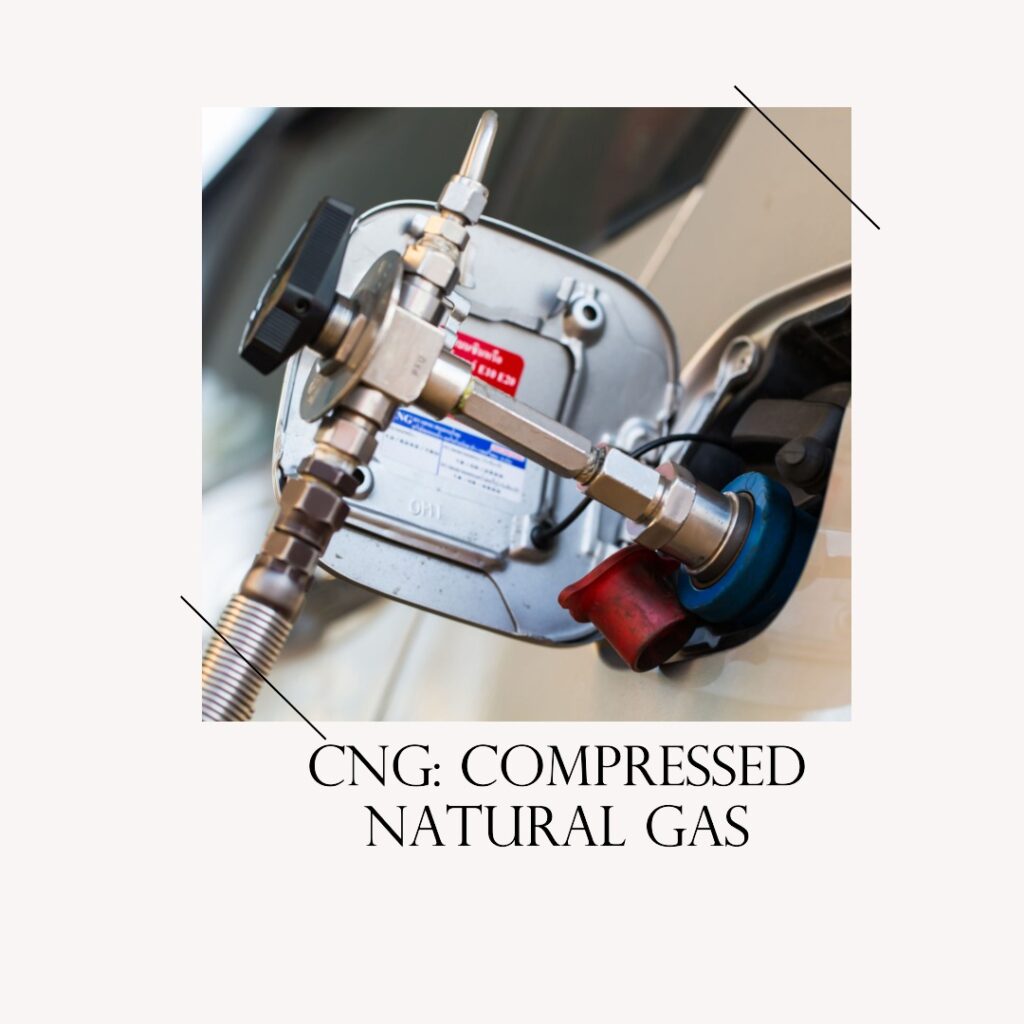The Ultimate Guide to CNG: Meaning, Uses, and Full Form

Compressed natural gas Alternative fuel (CNG) is a type of natural gas that has been compressed to reduce its volume and make it easier to store and transport. It is a clean-burning fuel that emits fewer pollutants and greenhouse gases than traditional gasoline and diesel.
As a result, CNG is becoming an increasingly popular alternative fuel option for various applications, including transportation and industries. CNG demand has grown as more people and businesses seek ways to reduce their environmental footprint and save on fuel costs. CNG is also more energy-efficient, meaning it requires less fuel to travel the same distance as gasoline or diesel vehicles.
With an abundance of natural gas reserves, CNG has the potential to be a cost-effective and sustainable fuel source for years to come. This article will provide an in-depth look at CNG and its full form, along with its advantages as an alternative fuel.
What is Compressed Natural Gas?
Compressed natural gas (CNG) is a type of natural gas compressed to reduce its volume for easier storage and transportation. It is composed mostly of methane, the main component of natural gas. It is a clean-burning fuel that emits lower pollutants and greenhouse gases than traditional gasoline or diesel.
The natural gas used to create CNG is extracted from underground reservoirs, processed to remove impurities, and then compressed to pressures of up to 3,600 pounds per square inch (PSI) to create CNG. This high-pressure compression reduces natural gas volume by a factor of around 200 times, making it easier to store and transport in specialized tanks.
Compared to other alternative fuels, such as liquefied petroleum gas (LPG) and hydrogen fuel cells, CNG has advantages. It is more widely available and easier to produce than hydrogen, and it emits lower levels of pollutants and greenhouse gases than LPG. In addition, CNG vehicles typically have longer driving ranges than electric vehicles, making them a practical option for long-distance travel.
Advantages of CNG as an Alternative Fuel
CNG has several advantages as an alternative fuel that make it an increasingly popular option for transportation and industries around the world CNG’s primary advantage is its environmental friendliness. Compared to traditional gasoline and diesel, CNG emits lower levels of pollutants and greenhouse gases. It produces up to 90% less nitrogen oxides, up to 75% less carbon monoxide (CO), and up to 25% less carbon dioxide emissions.
These lower emissions can improve air quality and reduce transportation impact on climate change. CNG is also more energy efficient than gasoline and diesel. This means that it requires less fuel to travel the same distance, which can reduce fuel costs for consumers and businesses. In addition, CNG is often cheaper than traditional fossil fuels due to natural gas reserves, making it a cost-effective alternative fuel option.
Furthermore, CNG is widely available in many regions around the world. As more countries and businesses look to reduce traditional fossil fuels, CNG demand is expected to grow. The abundance of natural gas reserves also means that CNG has the potential to be a sustainable fuel source for years to come.
The advantages of CNG as an alternative fuel make it an attractive option for various applications, including transportation and industries. Its energy efficiency, low emissions, cost-effectiveness, and availability make it a viable alternative to traditional fossil fuels.
Natural Gas Vehicles (NGVs)
Natural Gas Vehicles are vehicles that use compressed natural gas or liquefied natural gas as fuel instead of traditional gasoline or diesel. NGVs are becoming increasingly popular due to their environmental benefits, energy efficiency, and cost-effectiveness.
One of the main benefits of NGVs is their lower emissions of pollutants and greenhouse gases. NGVs emit fewer carbon emissions, which can improve air quality and reduce transportation impact on climate change. NGVs also emit lower levels of nitrogen oxides (NOx), particulates matter, and sulfur dioxide (SO2), which can have negative health effects.
NGVs are also more energy efficient than traditional gasoline or diesel vehicles. This means that they require less fuel to travel the same distance, which can reduce fuel costs for consumers and businesses. In addition, natural gas can reduce dependence on foreign oil and increase energy security.
There are two main types of NGVs: dedicated and bi-fuel. Dedicated NGVs run exclusively on natural gas. Bi-fuel NGVs have two separate fuel systems, one for natural gas and another for gasoline or diesel. Bi-fuel NGVs can switch between fuels depending on availability or driving conditions.
NGVs are used in a variety of applications, including passenger cars, trucks, buses, and even industrial vehicles. They are particularly popular in fleet applications, such as public transportation and delivery services, where fuel efficiency and cost savings are top priorities.
NGVs are an increasingly popular alternative to traditional gasoline and diesel vehicles due to their lower emissions, energy efficiency, and cost-effectiveness. As natural gas reserves grow, NGV use is expected to increase.
Use of CNG around the World
CNG is becoming an increasingly popular fuel source around the world. This is especially true for countries with a high demand for transportation fuel and who are seeking to reduce their dependence on traditional fossil fuels.
- Argentina: Argentina has one of the largest NGV fleets in the world, with over 2.4 million NGVs on its roads. This is due in part to government incentives and regulations that encourage natural gas use as a transportation fuel.
- Iran: Iran is another country with a large fleet of NGVs, with over 4.4 million vehicles using natural gas as a fuel source. The government has implemented policies to encourage CNG use, including offering subsidies to drivers who convert their vehicles to run on natural gas.
- Pakistan: Pakistan has been aggressively promoting CNG as a transportation fuel since the early 1990s, and it now has one of the largest CNG markets in the world. Over 3.2 million CNG vehicles run on CNG. The government has set a target of converting 50% of country vehicles to CNG by 2025.
There are many cities and industries around the world that use CNG as an alternative fuel source. For example,
- In the United States, many municipalities have converted their bus fleets to run on natural gas, including Los Angeles, New York City, and Dallas.
- The taxi industry in many cities, including Delhi, Mexico City, and Cairo, has also adopted CNG as a fuel source. This is due to its lower cost and environmental benefits.
- The shipping industry is also adopting CNG as a fuel source, with several major shipping companies, including Maersk and CMA CGM, investing in CNG-powered ships.
Environmentally Friendly and Energy-Efficient
Environmentally Friendly: CNG is a cleaner fuel than other fossil fuels like gasoline and diesel. When CNG is burned, it emits fewer pollutants such as carbon monoxide (CO), nitrogen oxides, and particulate matter (PM) that are harmful to the environment and human health. CNG emits 90% fewer pollutants than gasoline and diesel. CNG also has a higher-octane rating, which means it burns cleaner than conventional fuels, resulting in less pollution.
Energy-efficient: CNG is an energy-efficient fuel as it requires less energy to manufacture and transport than other fuels. CNG is produced by compressing natural gas, which is abundant and readily available in many parts of the world. CNG production is more energy-efficient than other fossil fuels. CNG produces energy at a lower energy cost than gasoline or diesel.
Role of CNG in reducing greenhouse gas emissions: Greenhouse gases, including carbon dioxide, methane, and nitrous oxide, contribute to global warming and climate change. CNG is a low-carbon fuel that emits fewer greenhouse gases than traditional fuels like gasoline and diesel. CNG can reduce greenhouse gas emissions by up to 20-30% compared to gasoline or diesel. This makes CNG an effective tool in decreasing the carbon footprint of the transportation sector, which contributes to greenhouse gas emissions.
conclusion
Compressed natural gas is an environmentally friendly and energy-efficient fuel with several advantages over traditional fossil fuels. emits fewer pollutants, requires less energy to produce and transport, and reduces greenhouse gas emissions.
This makes it a promising alternative fuel for transportation. With its availability and cost-effectiveness, CNG has the potential to play a significant role in reducing the carbon footprint of the transportation Indus CNG try.
As the world shifts towards cleaner and more sustainable energy sources, CNG is a viable option that can help us achieve our environmental goals. This is while still meeting our energy needs.
Hey, how much did you like The Ultimate Guide to CNG: Meaning, Uses, and Full Form Please share your view in the comment box. Also, please share this story with your friends on social media so they can also enjoy it, and for more such Full form, please bookmark storiespub.com.
FAQs
How is CNG produced?
CNG is produced by compressing natural gas, which is a fossil fuel abundant and readily available in many parts of the world.
Is CNG safe to use?
Yes, CNG is a non-toxic and non-corrosive fuel that is safer to use and store than gasoline or diesel.
How does CNG reduce greenhouse gas emissions?
CNG emits fewer greenhouse gases than traditional fuels like gasoline and diesel, making it an effective tool in reducing the carbon footprint of the transportation sector.
Are there CNG vehicles?
Yes, there are Natural Gas Vehicles (NGVs) designed to run on CNG. These vehicles have specialized engines that burn CNG efficiently.



